Eastern Europe
| Eastern Europe | |
|---|---|
 Geographic features of Eastern Europe |
Eastern Europe, also East Europe, is the eastern part of the European continent. There is no consensus as to the precise area it refers to, partly because the term has a wide range of geopolitical, geographical, cultural, and socioeconomic connotations. There are "almost as many definitions of Eastern Europe as there are scholars of the region".[1] A related United Nations paper adds that "every assessment of spatial identities is essentially a social and cultural construct".[2]
One definition describes Eastern Europe as a cultural (and econo-cultural) entity: the region lying in Europe with main characteristics consisting in Byzantine, Orthodox, and some Turco-Islamic influences.[2][3] Another definition was created during the Cold War and used more or less synonymously with the term Eastern Bloc. A similar definition names the formerly communist European states outside the Soviet Union as Eastern Europe.[3] Historians and social scientists increasingly view such definitions as outdated or relegating,[4][5][6][7][8] but they are still heard in everyday speech and used for statistical purposes.[9][10][11]
Definitions
Several definitions of Eastern Europe exist today, but they often lack precision or are extremely general. These definitions vary both across cultures and among experts, even political scientists, recently becoming more and more imprecise.[12]
Geographical
The Ural Mountains, Ural River, and the Caucasus Mountains are the geographical land border of the eastern edge of Europe. In the west, however, the cultural and religious boundaries of "Eastern Europe" are subject to considerable overlap and, most importantly, have undergone historical fluctuations, which make a precise definition of the western boundaries of Eastern Europe and the geographical midpoint of Europe somewhat difficult.
International organisations
UN Statistics Division
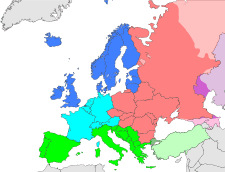
- The United Nations Statistics Division developed a selection of geographical regions and groupings of countries and areas, which are or may be used in compilation of statistics. In this collection, the following ten countries were classified as Eastern Europe:[10][11] Belarus, Bulgaria, Czech Republic, Hungary, Moldova, Poland, Romania, Russia, Slovakia, and Ukraine. The assignment of countries or areas to specific groupings is for statistical convenience and does not imply any assumption regarding political or other affiliation of countries or territories by the United Nations.[13] The United Nations' definition encompasses most of the states which were once under the Soviet Union's realm of influence and were part of the Warsaw Pact.
- Other agencies of the United Nations (like UNAIDS,[14] UNHCR,[15][16] ILO,[17] or UNICEF[18]) divide Europe into different regions and variously assign various states to those regions.
European Union
.png)
Eurovoc, a multilingual thesaurus maintained by the Publications Office of the European Union, provides entries for "23 EU languages"[19] (Bulgarian, Croatian, Czech, Danish, Dutch, English, Estonian, Finnish, French, German, Greek, Hungarian, Italian, Latvian, Lithuanian, Maltese, Polish, Portuguese, Romanian, Slovak, Slovenian, Spanish and Swedish) plus Serbian. Of these, those in italics are classified as "Eastern Europe" in this source. Other official web-pages of the European Union classify some of the above-mentioned countries as strictly Central European (Hungary, Poland, Slovakia, Czech Republic, Slovenia).[20][21][22][23][24]
Central Intelligence Agency
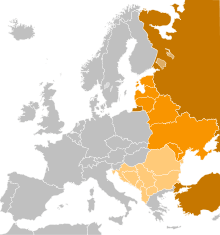
CIA defines Eastern Europe as Belarus, Estonia, Latvia, Lithuania, Moldova, Russia (transcontinental), Turkey (transcontinental) and Ukraine.
Political, military and economic
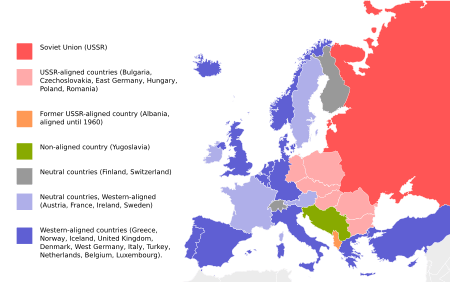
Historical
One view of the present boundaries of Eastern Europe came into being during the final stages of World War II. The area eventually came to encompass all the European countries which were under Soviet influence. Countries which had communist governments in the postwar era (1945-1991), and neutral countries were classified by the nature of their political regimes.
The Cold War increased the number of reasons for the division of Europe into two parts along the borders of NATO and Warsaw Pact states. (See: the Cold War section).
The economic organisation connecting the countries was the Council for Mutual Economic Assistance.
Contemporary
In recent years, after the fall of the USSR, a few political and economic organisations emerged in the region of Eastern Europe, including the Commonwealth of Independent States (CIS), and more recently the Eurasian Economic Union.
Cultural
Cultural view excludes from the definition of Eastern Europe states historically and culturally different, constituting part of the so-called Western world. This could potentially refer to various formerly communist countries of Central Europe, the Baltics, and the Balkans which have different political, religious, cultural, and economic histories from their eastern neighbors (e.g., Russia and Ukraine). (See: Classical antiquity and medieval origins section).
-
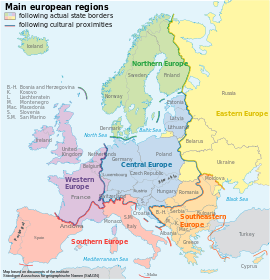
Cultural map of Europe by Ständiger Ausschuss für geographische Namen.
-

Distribution of the Cyrillic script worldwide.
-
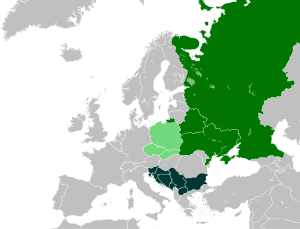 Countries where an East Slavic language is the national language
Countries where an East Slavic language is the national language
Religious
The East–West Schism is the break of communion and theology between what are now the Eastern (Orthodox) and Western (Roman Catholic, as well as from the 16th century also Protestant) churches which began in the 11th century and lasts until this very day. It divided Christianity in Europe, and consequently the world, into Western Christianity and Eastern Christianity.
-
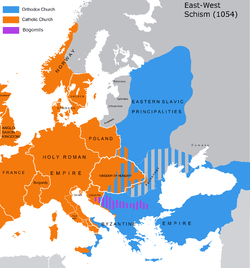
Religious division in 1054[3]
-
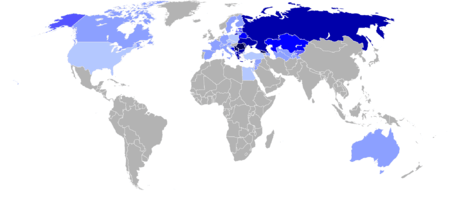
Countries by percentage of Eastern Orthodox Christians (Eastern Church).
-

Countries by percentage of Catholics(Western Churches).
-

Countries by percentage of Protestants (Western Churches).
- ^ "Atlas of the Historical Geography of the Holy Land". Rbedrosian.com. Retrieved 23 February 2013.
- ^ "home.comcast.net". Archived from the original on February 13, 2013. Retrieved 23 February 2013.
- ^ Dragan Brujić (2005). "Vodič kroz svet Vizantije (Guide to the Byzantine World)". Beograd. p. 51.
Contemporary developments
The fall of the Iron Curtain brought the end of the East–West division in Europe,[25] but this geopolitical concept is sometimes still used for quick reference by the media.[26]
Baltic states
Most sources place the Baltic states in Northern Europe whereas the CIA World Factbook places the region in Eastern Europe.
Transcaucasia
The Transcaucasia nations of Armenia, Azerbaijan, and Georgia are included in definitions of Eastern Europe and/or histories of Eastern Europe. They are located in the transition zone of Eastern Europe and Western Asia. They participate in the European Union's Eastern Partnership Program, and are members of the Council of Europe, which specifies that all three are geographically in Asia but have political and cultural connections to Turkey and Europe. Georgia has sought membership in NATO and the EU.
The World Factbook and National Geographic Society atlases, and the United Nations Statistics Division, have always listed and/or shown the three states within Asia. As with the Baltic states, the Transcaucasian nations differ somewhat, with Christian Georgia and Armenia culturally oriented more toward Eastern Europe, and Shiite Muslim Azerbaijan culturally oriented more toward the Asian Middle East.
Other former Soviet states
Several other former Soviet republics may be considered part of Eastern Europe
-
 Russia is a transcontinental country where the Western part is in Eastern Europe and the rest is in Asia.
Russia is a transcontinental country where the Western part is in Eastern Europe and the rest is in Asia. -
 Kazakhstan is a transcontinental country, predominantly in Asia, with a relatively small section in Europe.
Kazakhstan is a transcontinental country, predominantly in Asia, with a relatively small section in Europe. -
 Ukraine
Ukraine -
 Belarus
Belarus -
 Moldova
Moldova
Central Europe
The term "Central Europe" is often used by historians to designate former Holy Roman Empire and the Polish-Lithuanian Commonwealth, including modern-day Belarus and Ukraine, and thus overlapping with "Eastern Europe." The following countries are labeled Eastern European by some commentators and as Central European by others.[27][28][29]
-
 Austria
Austria -
 Czech Republic
Czech Republic -
 Croatia[30][31][32][33][34]
Croatia[30][31][32][33][34] -
 Hungary
Hungary -
 Poland
Poland -
 Slovakia
Slovakia -
 Slovenia (most often placed in Central Europe but sometimes in Southeastern Europe)[35]
Slovenia (most often placed in Central Europe but sometimes in Southeastern Europe)[35]
Southeastern Europe
Most Southeastern European states did not belong to the Eastern Bloc (save Bulgaria, Romania, and for a short time, Albania) although some of them were represented in the Cominform. Only some of them can be included in the classical former political definition of Eastern Europe. Some can be considered part of Southern Europe.[10] However, most can be characterized as belonging to South-eastern Europe, but some of them may also be included in Central Europe or Eastern Europe.[36]
-
 Albania belongs to Southeastern Europe.
Albania belongs to Southeastern Europe. -
 Bosnia and Herzegovina
Bosnia and Herzegovina -
 Bulgaria is in the central part of the Balkans; geographically belongs to Southern/Southeastern Europe and sometimes included in the North-Eastern Mediterranean, but can also be included in Eastern Europe in the Cold War.
Bulgaria is in the central part of the Balkans; geographically belongs to Southern/Southeastern Europe and sometimes included in the North-Eastern Mediterranean, but can also be included in Eastern Europe in the Cold War. -
 Cyprus is geographically situated in the eastern Mediterranean, off the coast of west Asian mainland, however due to its political, cultural, and historical ties to Europe, it is often regarded as part of Southern, and Southeastern Europe.
Cyprus is geographically situated in the eastern Mediterranean, off the coast of west Asian mainland, however due to its political, cultural, and historical ties to Europe, it is often regarded as part of Southern, and Southeastern Europe. -
 Greece is a rather unusual case and may be included, variously, in Western,[37] Southeastern[38] or Southern Europe.[39][40]
Greece is a rather unusual case and may be included, variously, in Western,[37] Southeastern[38] or Southern Europe.[39][40] -
 Macedonia belongs to Southeastern Europe.
Macedonia belongs to Southeastern Europe. -
 Montenegro belongs to Southeastern Europe.
Montenegro belongs to Southeastern Europe. -
 Romania can be included in Eastern Europe in the Cold War context, but is commonly referred to as belonging to Southeastern Europe[41] or Central Europe.[42]
Romania can be included in Eastern Europe in the Cold War context, but is commonly referred to as belonging to Southeastern Europe[41] or Central Europe.[42] -
 Serbia is included in notions of Southeastern, Southern and Central Europe
Serbia is included in notions of Southeastern, Southern and Central Europe -
 Turkey lies partially in Southeastern Europe: only the region known as East Thrace, which constitutes 3% of the country's total land mass, lies west of the Dardanelles, the Sea of Marmara, and the Bosphorus.
Turkey lies partially in Southeastern Europe: only the region known as East Thrace, which constitutes 3% of the country's total land mass, lies west of the Dardanelles, the Sea of Marmara, and the Bosphorus.
-
 Kosovo belongs to Southeastern Europe.
Kosovo belongs to Southeastern Europe. -
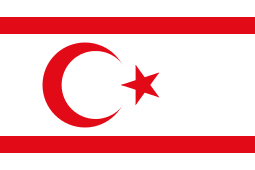 Northern Cyprus
Northern Cyprus
History
Classical antiquity and medieval origins
Ancient kingdoms of the region included Orontid Armenia Albania, Colchis and Iberia. These kingdoms were either from the start, or later on incorporated into various Iranian empires, including the Achaemenid Persian, Parthian, and Sassanid Persian Empires.[43] Parts of the Balkans and more northern areas were ruled by the Achaemenid Persians as well, including Thrace, Paeonia, Macedon, and most of the Black Sea coastal regions of Romania, Ukraine, and Russia.[44][45] Owing to the rivalry between Parthian Iran and Rome, and later Byzantium and the Sassanid Persians, the former would invade the region several times, although it was never able to hold the region, unlike the Sassanids who ruled over most of the Caucasus during their entire rule.[46]
The earliest known distinctions between east and west in Europe originate in the history of the Roman Republic. As the Roman domain expanded, a cultural and linguistic division appeared between the mainly Greek-speaking eastern provinces which had formed the highly urbanized Hellenistic civilization. In contrast the western territories largely adopted the Latin language. This cultural and linguistic division was eventually reinforced by the later political east–west division of the Roman Empire. The division between these two spheres was enhanced during Late Antiquity and the Middle Ages by a number of events. The Western Roman Empire collapsed starting the Early Middle Ages. By contrast, the Eastern Roman Empire, mostly known as the Byzantine Empire, managed to survive and even to thrive for another 1,000 years. The rise of the Frankish Empire in the west, and in particular the Great Schism that formally divided Eastern and Western Christianity, enhanced the cultural and religious distinctiveness between Eastern and Western Europe. Much of Eastern Europe was invaded and occupied by the Mongols.
The conquest of the Byzantine Empire, center of the Eastern Orthodox Church, by the Ottoman Empire in the 15th century, and the gradual fragmentation of the Holy Roman Empire (which had replaced the Frankish empire) led to a change of the importance of Roman Catholic/Protestant vs. Eastern Orthodox concept in Europe. Armour points out that the Cyrillic alphabet use is not a strict determinant for Eastern Europe, where from Croatia to Poland and everywhere in between, the Latin alphabet is used.[47] Greece's status as the cradle of Western civilization and an integral part of the Western world in the political, cultural and economic spheres has led to it being nearly always classified as belonging not to Eastern, but to Southern and/or Western Europe.[48] During the late sixteenth and early seventeenth centuries Eastern Europe enjoyed a relative high standard of living. This period is also called the east-central European golden age of around 1600.[49]
Interwar years
A major result of the First World War was the breakup of the Russian, Austro-Hungarian, and Ottoman empires, as well as partial losses to the German Empire. A surge of ethnic nationalism created a series of new states in Eastern Europe, validated by the Versailles Treaty of 1919. Poland was reconstituted after the partitions of the 1790s had divided it between Germany, Austria, and Russia. New countries included Finland, Estonia, Latvia, Lithuania, Ukraine (which was soon absorbed by the Soviet Union), Czechoslovakia, and Yugoslavia. Austria and Hungary had much reduced boundaries. Romania, Bulgaria and Albania likewise were independent. All the countries were heavily rural, with little industry and only a few urban centers. Nationalism was the dominant force but most of the countries had ethnic or religious minorities who felt threatened by majority elements. Nearly all became democratic in the 1920s, but all of them (except Czechoslovakia and Finland) gave up democracy during the depression years of the 1930s, in favor of autocratic or strong-man or single party states. The new states were unable to form stable military alliances, and one by one were too weak to stand up against Nazi Germany or the Soviet Union, which took them over between 1938 and 1945.
World War II and the onset of the Cold War
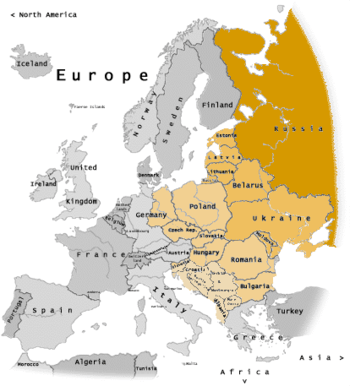
Russia, defeated in the First World War, lost territory as the Baltics and Poland made good their independence. The region was the main battlefield in the Second World War (1939–45), with German and Soviet armies sweeping back and forth, with millions of Jews killed by the Nazis, and millions of others killed by disease, starvation, and military action, or executed after being deemed as politically dangerous.[50] During the final stages of World War II the future of Eastern Europe was decided by the overwhelming power of the Soviet Red Army, as it swept the Germans aside. It did not reach Yugoslavia and Albania however. Finland was free but forced to be neutral in the upcoming Cold War. The region fell to Soviet control and Communist governments were imposed. Yugoslavia and Albania had their own Communist regimes. The Eastern Bloc with the onset of the Cold War in 1947 was mostly behind the Western European countries in economic rebuilding and progress. Winston Churchill, in his famous "Sinews of Peace" address of March 5, 1946 at Westminster College in Fulton, Missouri, stressed the geopolitical impact of the "iron curtain":
From Stettin in the Baltic to Trieste in the Adriatic an iron curtain has descended across the Continent. Behind that line lie all the capitals of the ancient states of Central and Eastern Europe. Warsaw, Berlin, Prague, Vienna, Budapest, Belgrade, Bucharest, and Sofia.

Eastern Bloc during the Cold War to 1989
The Soviet secret police, the NKVD, working in collaboration with local communists, created secret police forces using leadership trained in Moscow. As soon as the Red Army had expelled the Germans, this new secret police arrived to arrest political enemies according to prepared lists. The national Communists then took power in a normally gradualist manner, backed by the Soviets in many, but not all, cases. They took control of the Interior Ministries, which controlled the local police. They confiscated and redistributed farmland. Next the Soviets and their agents took control of the mass media, especially radio, as well as the education system. Third the communists seized control of or replaced the organizations of civil society, such as church groups, sports, youth groups, trade unions, farmers organizations, and civic organizations. Finally they engaged in large scale ethnic cleansing, moving ethnic minorities far away, often with high loss of life. After a year or two, the communists took control of private businesses and monitored the media and churches. For a while, cooperative non-Communist parties were tolerated. The communists had a natural reservoir of popularity in that they had destroyed Hitler and the Nazi invaders. Their goal was to guarantee long-term working-class solidarity.[51][52] Eastern Europe after 1945 usually meant all the European countries liberated and then occupied by the Soviet army. It included the German Democratic Republic (also known as East Germany), formed by the Soviet occupation zone of Germany. All the countries in Eastern Europe adopted communist modes of control. These countries were officially independent from the Soviet Union, but the practical extent of this independence – except in Yugoslavia, Albania, and to some extent Romania – was quite limited. Under pressure from Stalin these nations rejected grants from the American Marshall plan. Instead they participated in the Molotov Plan which later evolved into the Comecon (Council for Mutual Economic Assistance). When NATO was created in 1949, most countries of Eastern Europe became members of the opposing Warsaw Pact, forming a geopolitical concept that became known as the Eastern Bloc.
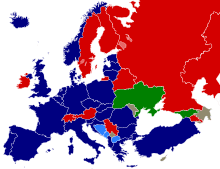
Current members Candidate countries Promised invitation |
Membership not goal Undeclared intent |
- First and foremost was the Soviet Union (which included the modern-day territories of Russia, Lithuania, Latvia, Estonia, Belarus, Ukraine, and Moldova). Other countries dominated by the Soviet Union were the German Democratic Republic, People's Republic of Poland, Czechoslovak Socialist Republic, People's Republic of Hungary, People's Republic of Bulgaria, and Socialist Republic of Romania.
- The Socialist Federal Republic of Yugoslavia (SFRY; formed after World War II and before its later dismemberment) was not a member of the Warsaw Pact. It was a founding member of the Non-Aligned Movement, an organization created in an attempt to avoid being assigned to either the NATO or Warsaw Pact blocs. The movement was demonstratively independent from both the Soviet Union and the Western bloc for most of the Cold War period, allowing Yugoslavia and its other members to act as a business and political mediator between the blocs.
- The Socialist People's Republic of Albania broke with the Soviet Union in the early 1960s as a result of the Sino-Soviet split, aligning itself instead with China. Albania formally left the Warsaw pact in September 1968 after the suppression of the Prague spring. When China established diplomatic relations with the United States in 1978, Albania also broke away from China. Albania and especially Yugoslavia were not unanimously appended to the Eastern Bloc, as they were neutral for a large part of the Cold War period.
Since 1989
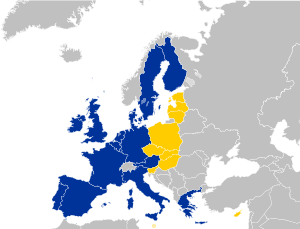

With the fall of the Iron Curtain in 1989, the political landscape of the Eastern Bloc, and indeed the world, changed. In the German reunification, the Federal Republic of Germany peacefully absorbed the German Democratic Republic in 1990. In 1991, COMECON, the Warsaw Pact, and the Soviet Union were dissolved. Many European nations which had been part of the Soviet Union regained their independence (Belarus, Moldova, Ukraine, as well as the Baltic States of Latvia, Lithuania, and Estonia). Czechoslovakia peacefully separated into the Czech Republic and Slovakia in 1993. Many countries of this region joined the European Union, namely Bulgaria, the Czech Republic, Estonia, Hungary, Latvia, Lithuania, Poland, Romania, and Slovakia.
See also
| Wikimedia Commons has media related to Eastern Europe. |
- Enlargement of the European Union
- Geography of the Soviet Union
- N-ost
- Slavic peoples
- Russian explorers
- European Union
- Międzymorze
European geography:
- Central Europe
- Northern Europe
- Southeast Europe
- Western Europe
- Central and Eastern Europe
- East-Central Europe
- European Russia
- Geographical midpoint of Europe
- Eastern European Group
Notes
- ↑ "The Balkans", Global Perspectives: A Remote Sensing and World Issues Site. Wheeling Jesuit University/Center for Educational Technologies, 1999–2002.
- 1 2 A Subdivision of Europe into Larger Regions by Cultural Criteria prepared by Peter Jordan, the framework of the Permanent Committee on Geographical Names (StAGN), Vienna, Austria, 2006
- 1 2 Ramet, Sabrina P. (1998). Eastern Europe: politics, culture, and society since 1939. Indiana University Press. p. 15. ISBN 0253212561. Retrieved 2011-10-05This definition is fulfilled by Russia, Belarus, Ukraine, Moldova, Romania, Bulgaria, Serbia, Bosnia and Herzegovina, Albania, Montenegro, Kosovo, Greece, Turkey, Georgia, Armenia and Azerbaijan.
- ↑ "The geopolitical conditions (...) are now a thing of the past, and some specialists today think that Eastern Europe has outlived its usefulness as a phrase.""Regions, Regionalism, Eastern Europe by Steven Cassedy". New Dictionary of the History of Ideas, Charles Scribner's Sons. 2005. Retrieved 2010-01-31
- ↑ "The Economist: Eastern Europe a bogus term - South Eastern Europe - The Sofia Echo".
- ↑ "One very common, but now outdated, definition of Eastern Europe was the Soviet-dominated communist countries of Europe."http://www.cotf.edu/earthinfo/balkans/BKdef.html
- ↑ "Too much writing on the region has – consciously or unconsciously – clung to an outdated image of 'Eastern Europe', desperately trying to patch together political and social developments from Budapest to Bukhara or Tallinn to Tashkent without acknowledging that this Cold War frame of reference is coming apart at the seams. Central Europe Review: Re-Viewing Central Europe By Sean Hanley, Kazi Stastna and Andrew Stroehlein, 1999
- ↑ Berglund, Sten; Ekman, Joakim; Aarebrot, Frank H. (2004). The handbook of political change in Eastern Europe. Edward Elgar Publishing [via Google Books]. p. 2. ISBN 9781781954324. Retrieved 2011-10-05.
The term 'Eastern Europe' is ambiguous and in many ways outdated.
- ↑ Archived April 3, 2015, at the Wayback Machine.. Eurovoc.europa.eu. Retrieved on 2015-03-04.
- 1 2 3 "United Nations Statistics Division- Standard Country and Area Codes Classifications (M49)".
- 1 2 Population Division, DESA, United Nations: World Population Ageing 1950-2050
- ↑ Drake, Miriam A. (2005) Encyclopedia of Library and Information Science, CRC Press
- ↑ "United Nations Statistics Division- Standard Country and Area Codes Classifications (M49)".
- ↑ "Countries".
- ↑ United Nations High Commissioner for Refugees. "UNHCR - Northern, Western, Central and Southern Europe".
- ↑ United Nations High Commissioner for Refugees. "UNHCR - Eastern Europe".
- ↑ "ILO".
- ↑ "Information by country - CEE/CIS and Baltic States". UNICEF.
- ↑ "EuroVoc". European Union. Retrieved 2016-01-30.
- ↑ "EUROPA - Hungary in the EU". 5 November 2010.
- ↑ "EUROPA - Czech Republic in the EU". 5 November 2010.
- ↑ "EUROPA - Poland in the EU". 5 November 2010.
- ↑ "EUROPA - Slovakia in the EU". 5 November 2010.
- ↑ "EUROPA - Slovenia in the EU". 2016-02-17. Retrieved 2016-03-09.
- ↑ V. Martynov, The End of East-West Division But Not the End of History, UN Chronicle, 2000 (available online)
- ↑ "Migrant workers: What we know". BBC News. 2007-08-21.
- ↑ Wallace, W. The Transformation of Western Europe London, Pinter, 1990
- ↑ Huntington, Samuel The Clash of Civilizations Simon & Schuster, 1996
- ↑ Johnson, Lonnie Central Europe: Enemies, Neighbours, Friends Oxford University Press, USA, 2001
- ↑ Lonnie Johnson, Central Europe: Enemies, Neighbors, Friends, Oxford University Pres
- ↑ "In the Heavy Shadow of the Ukraine/Russia Crisis, page 10" (PDF). European Bank for Reconstruction and Development. September 2014. Retrieved 15 January 2015.
- ↑ "UNHCR in Central Europe". UNCHR.
- ↑ "Central European Green Corridors - Fast charging cross-border infrastructure for electric vehicles, connecting Austria, Slovakia, Slovenia, Germany and Croatia" (PDF). Central European Green Corridors. October 2014.
- ↑ "Interreg CENTRAL EUROPE Homepage". Interreg CENTRAL EUROPE.
- ↑ Armstrong, Werwick. Anderson, James (2007). "Borders in Central Europe: From Conflict to Cooperation". Geopolitics of European Union Enlargement: The Fortress Empire. Routledge. p. 165. ISBN 978-1-134-30132-4.
- ↑ Bideleux and Jeffries (1998) A History of Eastern Europe: Crisis and Change
- ↑ inter alia, Peter John, Local Governance in Western Europe, 2001
- ↑ Greek Ministry of Tourism Travel Guide, General Information
- ↑ "Greece Location - Geography". indexmundi.com. Retrieved 2014-12-07.
- ↑ "UNdata | country profile | Greece". data.un.org. Retrieved 2014-12-07.
- ↑ Energy Statistics for the U.S. Government Archived February 5, 2009, at the Wayback Machine.
- ↑ "7 Invitees - Romania".
- ↑ Rapp, Stephen H. (2003), Studies In Medieval Georgian Historiography: Early Texts And Eurasian Contexts, pp. 292-294. Peeters Bvba ISBN 90-429-1318-5.
- ↑ The Oxford Classical Dictionary by Simon Hornblower and Antony Spawforth,ISBN 0-19-860641-9,"page 1515,"The Thracians were subdued by the Persians by 516"
- ↑ "A Companion to Ancient Macedonia". Retrieved 22 April 2015.
- ↑ "An Ethnohistorical Dictionary of the Russian and Soviet Empires". Retrieved 22 April 2015.
- ↑ Armour, Ian D. 2013. A History of Eastern Europe 1740–1918: Empires, Nations and Modernisation. London: Bloomsbury Academic. p. 23. ISBN 978-1849664882
- ↑ See, inter alia, Norman Davies, Europe: a History, 2010, Eve Johansson, Official Publications of Western Europe, Volume 1, 1984, Thomas Greer and Gavin Lewis, A Brief History of the Western World, 2004
- ↑ Baten, Jörg (2016). A History of the Global Economy. From 1500 to the Present. Cambridge University Press. p. 46. ISBN 9781107507180.
- ↑ Timothy Snyder, Bloodlands: Europe Between Hitler and Stalin (2011) excerpt and text search
- ↑ Anne Applebaum (2012). Iron Curtain: The Crushing of Eastern Europe, 1944-1956. Random House Digital, Inc. pp. 31–33. ISBN 9780385536431.
- ↑ Also Anne Applebaum, Iron Curtain: The Crushing of Eastern Europe, 1944–1956 introduction, pp xxix–xxxi online at Amazon.com
Further reading
- Applebaum, Anne. Iron Curtain: The Crushing of Eastern Europe, 1944–1956 (2012)
- Berend, Iván T. Decades of Crisis: Central and Eastern Europe before World War II (2001)
- Frankel, Benjamin. The Cold War 1945-1991. Vol. 2, Leaders and other important figures in the Soviet Union, Eastern Europe, China, and the Third World (1992), 379pp of biographies.
- Frucht, Richard, ed. Encyclopedia of Eastern Europe: From the Congress of Vienna to the Fall of Communism (2000)
- Gal, Susan and Gail Kligman, The Politics of Gender After Socialism, Princeton: Princeton University Press, 2000.
- Ghodsee, Kristen R.. Muslim Lives in Eastern Europe: Gender, Ethnicity and the Transformation of Islam in Postsocialist Bulgaria. Princeton: Princeton University Press, 2009.
- Ghodsee, Kristen R.. Lost in Transition: Ethnographies of Everyday Life After Communism, Duke University Press, 2011.
- Held, Joseph, ed. The Columbia History of Eastern Europe in the Twentieth Century (1993)
- Jelavich, Barbara. History of the Balkans, Vol. 1: Eighteenth and Nineteenth Centuries (1983); History of the Balkans, Vol. 2: Twentieth Century (1983)
- Lipton, David (2002). "Eastern Europe". In David R. Henderson (ed.). Concise Encyclopedia of Economics (1st ed.). Library of Economics and Liberty. OCLC 317650570, 50016270, 163149563
- Myant, Martin; Drahokoupil, Jan (2010). Transition Economies: Political Economy in Russia, Eastern Europe, and Central Asia. Wiley-Blackwell. ISBN 978-0-470-59619-7
- Ramet, Sabrina P. Eastern Europe: Politics, Culture, and Society Since 1939 (1999)
- Roskin, Michael G. The Rebirth of East Europe (4th ed. 2001); 204pp
- Simons, Thomas W. Eastern Europe in the Postwar World (1991)
- Snyder, Timothy. Bloodlands: Europe Between Hitler and Stalin (2011)
- Swain, Geoffrey and Nigel Swain, Eastern Europe Since 1945 (3rd ed. 2003)
- Verdery, Katherine. What Was Socialism and What Comes Next? Princeton: Princeton University Press, 1996.
- Walters, E. Garrison. The Other Europe: Eastern Europe to 1945 (1988) 430pp; country-by-country coverage
- Wolchik, Sharon L. and Jane L. Curry, eds. Central and East European Politics: From Communism to Democracy (2nd ed. 2010), 432pp
External links
| Wikimedia Commons has media related to Eastern Europe. |
| Wikiquote has quotations related to: East/Central Europe |
Coordinates: 50°00′00″N 30°00′00″E / 50.0000°N 30.0000°E
.svg.png)
.svg.png)
_-_Crimea_disputed.svg.png)
.svg.png)
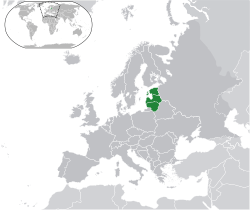
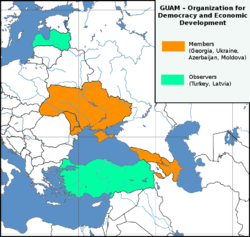
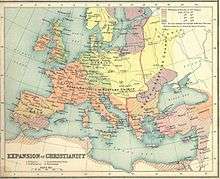
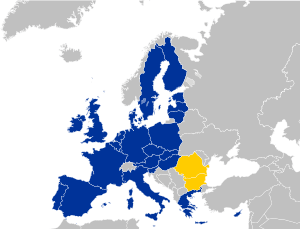
.svg.png)